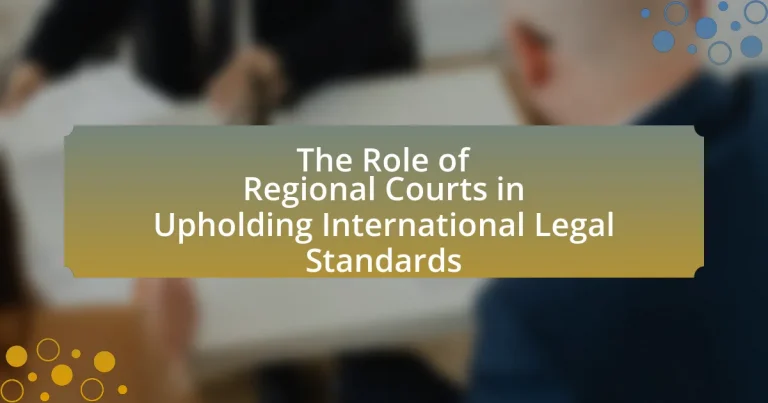Regional courts are judicial bodies established to adjudicate legal disputes and uphold the rule of law within specific geographical areas, focusing on issues such as human rights, trade, and environmental law. This article examines the functions, characteristics, and operational mechanisms of regional courts, highlighting their differences from national courts and their role in enforcing international legal standards. It also addresses the challenges these courts face, including jurisdictional limitations and political pressures, while exploring best practices and innovations that could enhance their effectiveness in promoting accountability and compliance with international norms. The discussion emphasizes the significance of regional courts in the broader context of international law and their potential future impact.

What are Regional Courts and Their Functions?
Regional courts are judicial bodies established within specific geographical areas to adjudicate legal disputes and uphold the rule of law. Their functions include interpreting and applying regional laws, resolving civil and criminal cases, and ensuring compliance with international legal standards. For instance, the European Court of Human Rights, a prominent regional court, enforces the European Convention on Human Rights, providing a mechanism for individuals to seek justice against state violations. This court’s decisions are binding on member states, illustrating how regional courts play a crucial role in maintaining legal accountability and protecting human rights within their jurisdictions.
How do Regional Courts differ from National Courts?
Regional Courts differ from National Courts primarily in their jurisdiction and scope of authority. Regional Courts typically handle cases that involve multiple countries or regional legal frameworks, focusing on issues such as human rights, trade, and environmental law, while National Courts operate within the legal boundaries of a single country, addressing domestic laws and regulations. For example, the European Court of Human Rights adjudicates cases involving member states of the Council of Europe, enforcing international human rights standards, whereas a National Court, like the Supreme Court of the United States, interprets and applies U.S. law without regard to international treaties unless they are incorporated into domestic law. This distinction highlights the broader, transnational focus of Regional Courts compared to the localized, national focus of National Courts.
What are the key characteristics of Regional Courts?
Regional Courts are judicial bodies that primarily handle cases within specific geographic areas, focusing on regional legal issues and international law compliance. They typically possess jurisdiction over a range of matters, including human rights violations, trade disputes, and environmental issues, thereby ensuring adherence to international legal standards. Regional Courts often operate under treaties or agreements among member states, which define their authority and procedural rules. For instance, the European Court of Human Rights enforces the European Convention on Human Rights, demonstrating how such courts uphold regional commitments to international norms. Additionally, these courts usually feature a panel of judges from different member states, promoting diverse legal perspectives and fostering regional cooperation in legal matters.
How do Regional Courts operate within their jurisdictions?
Regional Courts operate within their jurisdictions by adjudicating cases that involve violations of regional laws and international legal standards. These courts have the authority to interpret and apply legal principles established by regional treaties and agreements, ensuring compliance with international human rights norms. For instance, the European Court of Human Rights hears cases from member states regarding alleged breaches of the European Convention on Human Rights, providing a mechanism for individuals to seek justice when national courts fail to protect their rights. This operational framework reinforces the rule of law and promotes accountability among states, as evidenced by the court’s ability to issue binding judgments that member states are obligated to follow.
Why are Regional Courts important in the context of International Law?
Regional Courts are important in the context of International Law because they provide a mechanism for enforcing human rights and resolving disputes within specific geographic areas. These courts, such as the European Court of Human Rights and the Inter-American Court of Human Rights, play a crucial role in interpreting international treaties and ensuring compliance by member states. For instance, the European Court has issued over 20,000 judgments since its establishment, significantly influencing national laws and policies across Europe. This enforcement of international legal standards helps to promote accountability and protect individual rights, thereby strengthening the overall framework of international law.
What role do Regional Courts play in enforcing international treaties?
Regional Courts play a crucial role in enforcing international treaties by interpreting and applying treaty provisions within their jurisdictions. These courts ensure compliance with international obligations by adjudicating disputes that arise under treaties, thereby providing a mechanism for accountability among states. For instance, the European Court of Human Rights enforces the European Convention on Human Rights, allowing individuals to bring cases against states for violations, which reinforces the treaty’s authority and promotes adherence to international legal standards.
How do Regional Courts contribute to the development of international legal standards?
Regional Courts contribute to the development of international legal standards by interpreting and applying international law within their jurisdictions, thereby influencing legal norms and practices. For instance, the European Court of Human Rights has established significant precedents that shape human rights law across Europe and beyond, such as the landmark case of Handyside v. United Kingdom, which set standards for freedom of expression. Additionally, regional courts often engage in dialogue with international legal bodies, facilitating the harmonization of laws and promoting adherence to international treaties, as seen in the Inter-American Court of Human Rights’ rulings that reinforce the principles of the American Convention on Human Rights. This interplay not only enhances the enforcement of international legal standards but also encourages states to align their domestic laws with these evolving norms.

How do Regional Courts Uphold International Legal Standards?
Regional courts uphold international legal standards by interpreting and applying international treaties and conventions within their jurisdictions. These courts, such as the European Court of Human Rights and the Inter-American Court of Human Rights, ensure compliance with international norms by adjudicating cases that involve violations of human rights and other international obligations. For instance, the European Court of Human Rights has established a body of case law that reinforces the European Convention on Human Rights, thereby influencing national legal systems to align with international standards. This process not only provides justice to individuals but also promotes accountability among states, thereby strengthening the overall framework of international law.
What mechanisms do Regional Courts use to uphold these standards?
Regional Courts uphold international legal standards through various mechanisms, including judicial review, interpretation of treaties, and enforcement of human rights protections. These courts assess the compatibility of national laws with international obligations, ensuring that member states adhere to established legal frameworks. For instance, the European Court of Human Rights interprets the European Convention on Human Rights, providing binding judgments that member states must implement, thereby reinforcing compliance with international human rights standards. Additionally, Regional Courts often issue advisory opinions, guiding states on legal obligations and promoting uniformity in the application of international law.
How do judicial decisions in Regional Courts influence international law?
Judicial decisions in Regional Courts significantly influence international law by interpreting and applying international legal standards within their jurisdictions, thereby setting precedents that can shape broader legal principles. For instance, the European Court of Human Rights has established binding interpretations of the European Convention on Human Rights, which member states are obligated to follow, thus impacting the development of human rights law globally. Additionally, rulings from regional courts often inform the decisions of international tribunals, as seen when the Inter-American Court of Human Rights’ judgments are referenced in cases before the International Criminal Court, illustrating the interconnectedness of regional and international legal frameworks.
What is the role of legal precedents in Regional Courts?
Legal precedents in Regional Courts serve as authoritative guidelines that influence the interpretation and application of laws in similar cases. These precedents ensure consistency and predictability in judicial decisions, which is essential for upholding international legal standards. For instance, when a Regional Court references a previous ruling, it reinforces the legal principles established in that case, thereby promoting uniformity in the application of law across different jurisdictions. This reliance on established precedents helps to maintain the integrity of the legal system and supports the enforcement of international norms, as seen in cases adjudicated by the European Court of Human Rights, where past decisions shape future rulings.
How do Regional Courts interact with international legal bodies?
Regional Courts interact with international legal bodies primarily through the application of international law and the enforcement of international legal standards within their jurisdictions. These courts often refer to international treaties, conventions, and rulings from international courts, such as the International Court of Justice, to guide their decisions and ensure compliance with global legal norms. For instance, the European Court of Human Rights frequently cites the European Convention on Human Rights, which is an international treaty, to adjudicate cases, thereby reinforcing the relationship between regional and international legal frameworks. This interaction not only enhances the legitimacy of regional courts but also promotes the harmonization of legal standards across different jurisdictions.
What is the relationship between Regional Courts and the International Court of Justice?
Regional Courts operate alongside the International Court of Justice (ICJ) to enforce international law within specific geographic areas. While the ICJ serves as the principal judicial organ of the United Nations, adjudicating disputes between states and providing advisory opinions, Regional Courts focus on legal matters pertinent to their respective regions, such as the European Court of Human Rights or the Inter-American Court of Human Rights. These courts often interpret and apply international law in ways that can complement or influence the ICJ’s rulings, thereby contributing to a cohesive international legal framework. For instance, decisions from Regional Courts can inform the ICJ’s understanding of human rights norms, illustrating how regional jurisprudence can impact global legal standards.
How do Regional Courts collaborate with international organizations?
Regional Courts collaborate with international organizations through mechanisms such as information sharing, joint initiatives, and mutual recognition of legal standards. For instance, the European Court of Human Rights often engages with the United Nations to align its rulings with international human rights norms, thereby enhancing the enforcement of these standards across member states. Additionally, regional courts may participate in training programs and workshops organized by international bodies, which fosters a better understanding of global legal frameworks and promotes consistency in legal interpretations. This collaboration is crucial for ensuring that regional legal practices are in harmony with international obligations, thereby reinforcing the rule of law on a broader scale.

What Challenges do Regional Courts Face in Upholding International Legal Standards?
Regional courts face significant challenges in upholding international legal standards, primarily due to issues of jurisdiction, varying national laws, and political pressures. Jurisdictional limitations often restrict regional courts from addressing cases that fall outside their defined scope, which can hinder the enforcement of international norms. Additionally, the divergence in national legal frameworks can create inconsistencies in how international standards are interpreted and applied, leading to unequal protection of rights across different jurisdictions. Political pressures from member states can further complicate the courts’ ability to operate independently, as governments may resist rulings that conflict with national interests or policies. These factors collectively undermine the effectiveness of regional courts in promoting and enforcing international legal standards.
What are the common obstacles encountered by Regional Courts?
Regional Courts commonly encounter obstacles such as limited resources, jurisdictional conflicts, and political interference. Limited resources hinder their ability to effectively manage caseloads, resulting in delays and reduced access to justice. Jurisdictional conflicts arise when there is ambiguity regarding the authority of different courts, complicating the enforcement of legal standards. Political interference can undermine the independence of Regional Courts, affecting their decision-making processes and the impartiality of their rulings. These challenges collectively impede the courts’ ability to uphold international legal standards effectively.
How do political influences affect the decisions of Regional Courts?
Political influences significantly affect the decisions of Regional Courts by shaping judicial interpretations and outcomes based on prevailing governmental ideologies. For instance, in countries where the judiciary is not fully independent, political pressures can lead to rulings that align with the interests of the ruling party, undermining the impartiality of legal standards. A notable example is the European Court of Human Rights, where member states often exert influence over court decisions through political lobbying, impacting the enforcement of international human rights standards. This dynamic illustrates how political contexts can compromise the ability of Regional Courts to uphold international legal norms effectively.
What are the limitations of Regional Courts in enforcing international standards?
Regional Courts face significant limitations in enforcing international standards primarily due to their jurisdictional constraints. These courts often operate within specific geographic boundaries and are limited to the member states that recognize their authority, which can hinder their ability to address violations occurring outside these jurisdictions. Additionally, the enforcement mechanisms available to Regional Courts are often weak; they may lack the power to compel compliance from states, relying instead on voluntary adherence to their rulings. For instance, the Inter-American Court of Human Rights can issue binding judgments, but compliance is contingent upon the political will of member states, leading to inconsistent enforcement of international human rights standards. Furthermore, Regional Courts may encounter challenges related to differing legal interpretations and cultural contexts among member states, complicating the uniform application of international standards.
How can Regional Courts improve their effectiveness?
Regional Courts can improve their effectiveness by enhancing case management systems to streamline processes and reduce backlog. Efficient case management allows for quicker resolution of cases, which is critical in maintaining the rule of law and upholding international legal standards. For instance, the European Court of Human Rights implemented a new case management system that significantly reduced the average processing time for cases, demonstrating that systematic improvements can lead to better outcomes. Additionally, investing in training for judges and court staff on international legal standards ensures that decisions are informed and consistent, further strengthening the courts’ role in upholding these standards.
What best practices can Regional Courts adopt to enhance their role?
Regional Courts can enhance their role by implementing standardized procedures for case management and adopting technology for efficient communication. Standardized procedures streamline processes, reduce delays, and ensure consistency in rulings, which is essential for upholding international legal standards. For instance, the European Court of Human Rights has established clear guidelines for case submissions, which has improved efficiency and transparency. Additionally, utilizing technology, such as online filing systems and virtual hearings, can facilitate access to justice and improve the overall effectiveness of the courts. Studies show that courts employing such technologies experience faster resolution times and increased public trust.
How can Regional Courts foster greater cooperation with national legal systems?
Regional Courts can foster greater cooperation with national legal systems by establishing formal mechanisms for collaboration, such as joint training programs and information-sharing platforms. These initiatives enhance mutual understanding of legal frameworks and promote adherence to international legal standards. For instance, the European Court of Human Rights collaborates with national courts through the “Pilot Judgments” procedure, which addresses systemic issues in member states, thereby reinforcing the application of human rights law at the national level. This approach not only improves the effectiveness of legal systems but also ensures that regional jurisprudence is integrated into national practices, ultimately strengthening the rule of law across jurisdictions.
What are the future prospects for Regional Courts in the context of International Law?
The future prospects for Regional Courts in the context of International Law are promising, as they are increasingly recognized for their role in enforcing human rights and resolving disputes within specific regions. Regional Courts, such as the European Court of Human Rights and the Inter-American Court of Human Rights, have demonstrated effectiveness in interpreting international legal standards and providing justice to individuals. Their influence is expected to grow as states continue to seek mechanisms for accountability and compliance with international norms, particularly in light of rising global challenges such as human rights violations and environmental issues. The increasing number of cases brought before these courts indicates a trend towards greater reliance on regional judicial mechanisms, reinforcing their significance in the international legal landscape.
How might changes in international relations impact Regional Courts?
Changes in international relations can significantly impact Regional Courts by altering their jurisdiction, effectiveness, and the willingness of states to comply with their rulings. For instance, shifts in diplomatic ties or power dynamics may lead to increased political pressure on these courts, affecting their independence and authority. Historical examples include the European Court of Human Rights facing challenges when member states, such as Russia, have shown reluctance to adhere to its judgments, reflecting how geopolitical tensions can undermine judicial effectiveness. Additionally, changes in international treaties or alliances can redefine the scope of cases that Regional Courts are able to address, thereby influencing their role in upholding international legal standards.
What innovations could strengthen the role of Regional Courts in upholding international standards?
Innovations that could strengthen the role of Regional Courts in upholding international standards include the implementation of digital case management systems and enhanced training programs for judges. Digital case management systems streamline processes, improve accessibility, and facilitate the sharing of information across jurisdictions, thereby increasing efficiency and transparency. Enhanced training programs for judges on international law and human rights standards ensure that they are well-equipped to interpret and apply these standards effectively. For instance, the European Court of Human Rights has adopted such training initiatives, which have led to improved judicial outcomes and adherence to international norms.


